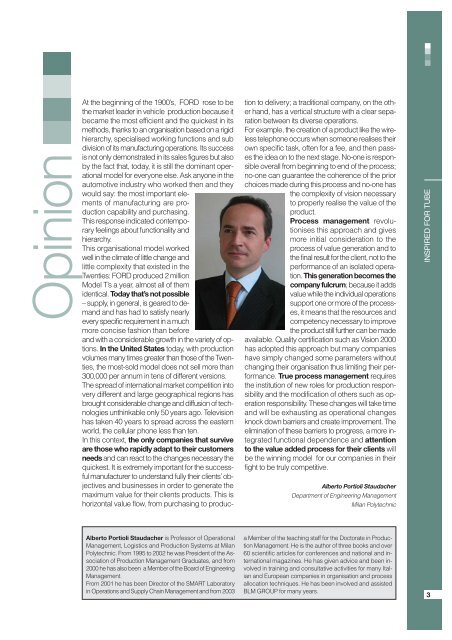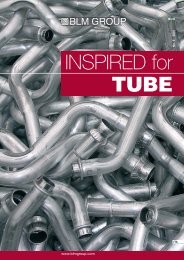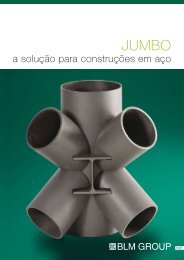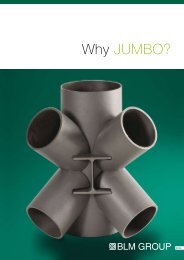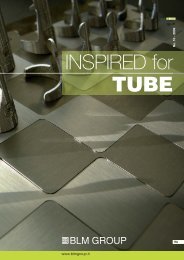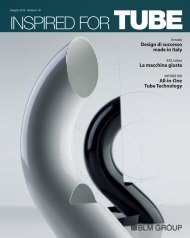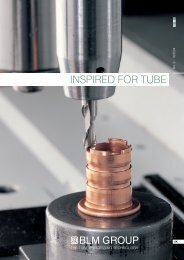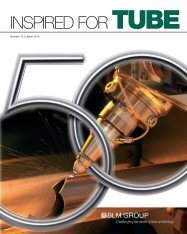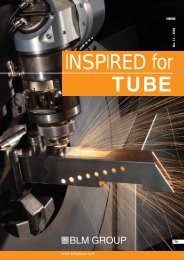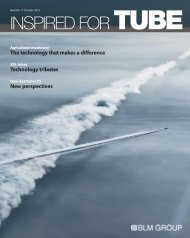Issue n. 3 - April 2005Download pdf - BLM GROUP
Issue n. 3 - April 2005Download pdf - BLM GROUP
Issue n. 3 - April 2005Download pdf - BLM GROUP
Create successful ePaper yourself
Turn your PDF publications into a flip-book with our unique Google optimized e-Paper software.
Opinion<br />
At the beginning of the 1900’s, FORD rose to be<br />
the market leader in vehicle production because it<br />
became the most efficient and the quickest in its<br />
methods, thanks to an organisation based on a rigid<br />
hierarchy, specialised working functions and sub<br />
division of its manufacturing operations. Its success<br />
is not only demonstrated in its sales figures but also<br />
by the fact that, today, it is still the dominant operational<br />
model for everyone else. Ask anyone in the<br />
automotive industry who worked then and they<br />
would say: the most important elements<br />
of manufacturing are production<br />
capability and purchasing.<br />
This response indicated contemporary<br />
feelings about functionality and<br />
hierarchy.<br />
This organisational model worked<br />
well in the climate of little change and<br />
little complexity that existed in the<br />
Twenties: FORD produced 2 million<br />
Model T’s a year, almost all of them<br />
identical. Today that’s not possible<br />
– supply, in general, is geared to demand<br />
and has had to satisfy nearly<br />
every specific requirement in a much<br />
more concise fashion than before<br />
and with a considerable growth in the variety of options.<br />
In the United States today, with production<br />
volumes many times greater than those of the Twenties,<br />
the most-sold model does not sell more than<br />
300,000 per annum in tens of different versions.<br />
The spread of international market competition into<br />
very different and large geographical regions has<br />
brought considerable change and diffusion of technologies<br />
unthinkable only 50 years ago. Television<br />
has taken 40 years to spread across the eastern<br />
world, the cellular phone less than ten.<br />
In this context, the only companies that survive<br />
are those who rapidly adapt to their customers<br />
needs and can react to the changes necessary the<br />
quickest. It is extremely important for the successful<br />
manufacturer to understand fully their clients’ objectives<br />
and businesses in order to generate the<br />
maximum value for their clients products. This is<br />
horizontal value flow, from purchasing to production<br />
to delivery; a traditional company, on the other<br />
hand, has a vertical structure with a clear separation<br />
between its diverse operations.<br />
For example, the creation of a product like the wireless<br />
telephone occurs when someone realises their<br />
own specific task, often for a fee, and then passes<br />
the idea on to the next stage. No-one is responsible<br />
overall from beginning to end of the process;<br />
no-one can guarantee the coherence of the prior<br />
choices made during this process and no-one has<br />
the complexity of vision necessary<br />
to properly realise the value of the<br />
product.<br />
Process management revolutionises<br />
this approach and gives<br />
more initial consideration to the<br />
process of value generation and to<br />
the final result for the client, not to the<br />
performance of an isolated operation.<br />
This generation becomes the<br />
company fulcrum; because it adds<br />
value while the individual operations<br />
support one or more of the processes,<br />
it means that the resources and<br />
competency necessary to improve<br />
the product still further can be made<br />
available. Quality certification such as Vision 2000<br />
has adopted this approach but many companies<br />
have simply changed some parameters without<br />
changing their organisation thus limiting their performance.<br />
True process management requires<br />
the institution of new roles for production responsibility<br />
and the modification of others such as operation<br />
responsibility. These changes will take time<br />
and will be exhausting as operational changes<br />
knock down barriers and create improvement. The<br />
elimination of these barriers to progress, a more integrated<br />
functional dependence and attention<br />
to the value added process for their clients will<br />
be the winning model for our companies in their<br />
fight to be truly competitive.<br />
Alberto Portioli Staudacher<br />
Department of Engineering Management<br />
Milan Polytechnic<br />
INSPIRED FOR TUBE<br />
Alberto Portioli Staudacher is Professor of Operational<br />
Management, Logistics and Production Systems at Milan<br />
Polytechnic. From 1995 to 2002 he was President of the Association<br />
of Production Management Graduates, and from<br />
2000 he has also been a Member of the Board of Engineering<br />
Management.<br />
From 2001 he has been Director of the SMART Laboratory<br />
in Operations and Supply Chain Management and from 2003<br />
a Member of the teaching staff for the Doctorate in Production<br />
Management. He is the author of three books and over<br />
60 scientific articles for conferences and national and international<br />
magazines. He has given advice and been involved<br />
in training and consultative activities for many Italian<br />
and European companies in organisation and process<br />
allocation techniques. He has been involved and assisted<br />
<strong>BLM</strong> <strong>GROUP</strong> for many years.<br />
3


